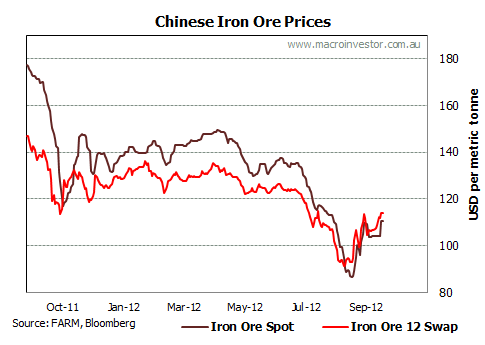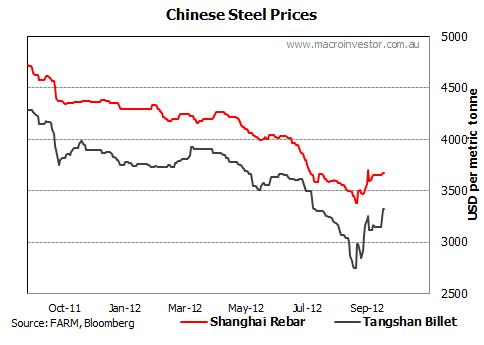The Golden Week may not have been overly kind to China but it did no harm whatsoever to the iron ore price:

I’ve noted over the past few days that the futures market was signaling increased confidence in Chinese restocking and now the physical market is following through:

As is the steel market in China:

So, for now, we definitely look set to retest the new resistance at $120, at least for swaps. I think it will fail, more or less. But I do expect the $100-$120 range to be in force for the next six months. To me this makes it likely that we’ll only see one more rate cut before we pause for breath.
But that won’t be the end of it. In recent weeks I have recounted how the new swing prices for iron in the medium term will be between $80 and $100 once we get past the little flush of stimulus currently in the pipeline. That means there will have to be further substantial cuts to Australia’s projected iron ore expansion plans.
Yesterday I also noted that Vale has already been cutting some iron ore production lines. Today, a fascinating report from China on the travails of Sino Iron elegantly illustrates that we are only at the leading edge of Australian rationalistion:
CITIC Pacific Ltd., a subsidiary of China’s biggest state-owned investment company CITIC, filed an application with the Stock Exchange of Hong Kong Ltd. on Sept. 25, saying it was going to raise an additional US$2.5 billion by issuing mid-term notes for its iron ore mining project in Western Australia, the Chinese-language business weekly Investor Journal reports.
CITIC Pacific bought two mining companies and acquired 25-year mining rights for two billion tons of magnetite in Cape Preston, Western Australia from Australian tycoon Clive Palmer in March 2006. The companies have a total of six production lines, with an annual processing capacity of 28 million tonnes of iron ore over the 25 years, the report said.
As of late June, CITIC Pacific had already invested US$7.8 billion in the iron ore mining project, exceeding the US$4.2 billion forecast in 2009, by 86% on account of sizeable loan interest rate payments and soaring costs.
A subsidiary of CITIC Pacific Mining called Sino Iron has subsequently formed to manage the project.
When CITIC Pacific bought the mining rights from Palmer in mid-2006, the deal was considered the largest overseas resource investment ever made by a Chinese company. It was also one of the few investments of its kind, given that the purchasing company had 100% Chinese ownership. It was also the only substantial project in Australia’s iron ore sector that had Chinese backing.
However, the launch of project has been postponed several times due to factors including labor issues which have generated unexpected expenditure.
Chang Zhenming, CITIC Pacific’s managing director, said the first production line at the mine wouldn’t be operational in August as scheduled, and had been postponed until November.
A company source said its management team also intended to invest in a second production line within the year.
A Goldman Sachs research report said that falling iron ore prices had posed additional difficulties for CITIC Pacific, as far as making its production line operational was concerned. The possibility of the company delaying production due to high costs could not be ruled out. However, if the production does not begin, the company would be unable to recover its investment costs in the initial phase and also faces the risk of its asset’s values diminishing.
On the contrary, if the company deferred its production, its investment costs would mount further.
Meanwhile, company management blamed delays on an “approval process” that was taking longer than expected and fueling labor costs, which had risen by about US$350 million.
Along with soaring costs, the Chinese company is also facing other challenges, including a lack of familiarity with Australia’s environmental regulations.
An analyst said that while development costs of CITIC Pacific’s Western Australia project were US$81 per tonne, iron ore prices needed to rebound to at least US$108, for the company to become profitable.
The Goldman Sachs research report also noted that the average iron ore price in early 2012 fell to US$87 per tonne from US$138 per tonne, making it difficult for the financial research company to predict CITIC Pacific’s short-term prospects.
That is a lot of money going to waste and a lot of face that’ll need to be saved.

